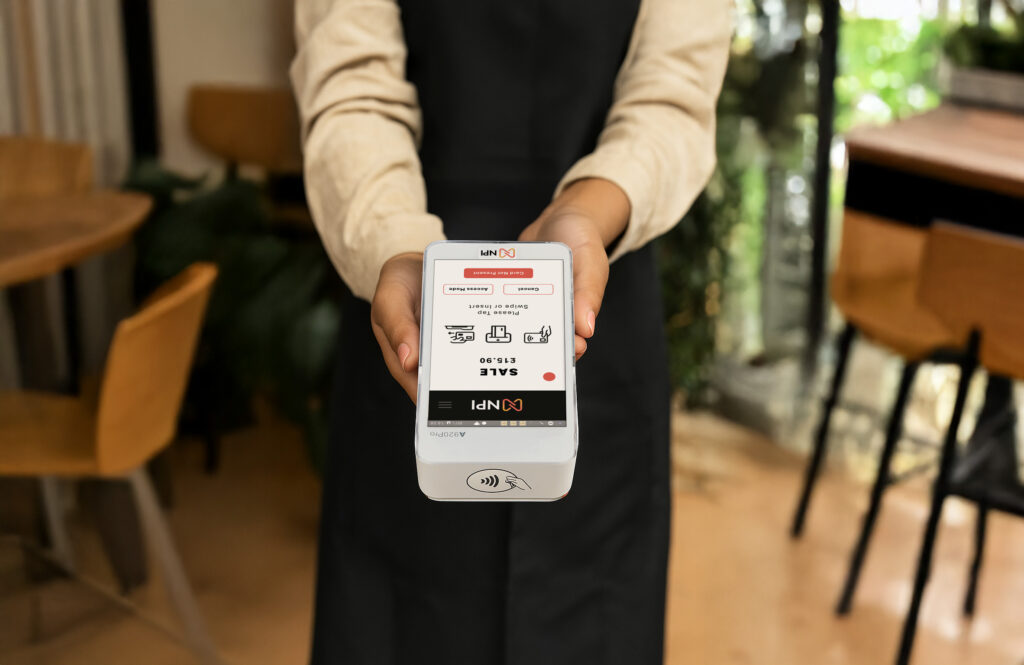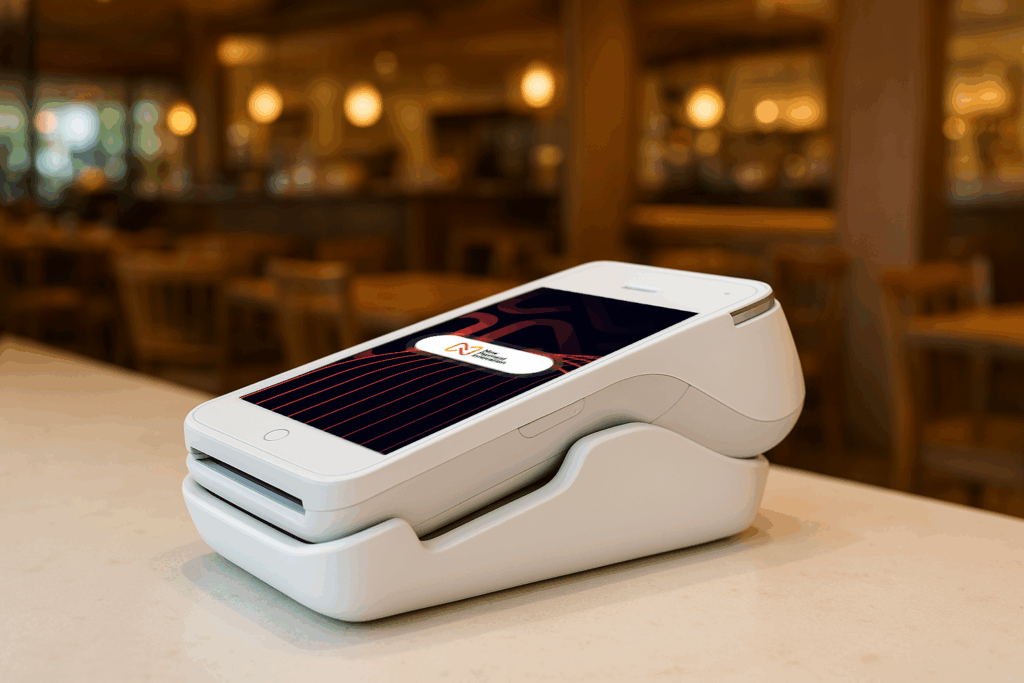Contactless card payments remain dominant, with the average UK consumer tapping their cards over 20 times a month. For UK small businesses, contactless payments have evolved from a convenience feature to an essential service that customers expect as standard.
It’s estimated that over 90% of consumers make contactless payments at least once a month or more frequently, making it clear that businesses without contactless capabilities risk losing significant custom to competitors who offer this convenience.
This comprehensive guide covers everything UK small business owners need to know about contactless payments, from understanding the technology and benefits to implementing the right solution for your business.
Understanding Contactless Payment Technology
How Contactless Payments Work
Contactless payments use Near Field Communication (NFC) technology to enable secure transactions with a simple tap or wave of a payment card, smartphone, or wearable device. Card machines incorporate NFC technology to enable contactless payment, where a cardholder authorises a payment by tapping their card against the reader.
The process typically takes just seconds:
- Customer taps their card or device on the reader
- The terminal communicates with the payment device
- Transaction details are encrypted and transmitted
- Payment is authorised and confirmed instantly
Security Features
Modern contactless payments include multiple security layers:
- Encryption of all transaction data
- Unique transaction codes for each payment
- Spending limits that trigger PIN verification for larger amounts
- Device-specific authentication for mobile wallets
Types of Contactless Payments
UK consumers can make contactless payments using:
- Contactless debit and credit cards
- Mobile wallets (Apple Pay, Google Pay, Samsung Pay)
- Contactless-enabled smartwatches and fitness trackers
- Digital payment apps and services
Benefits of Accepting Contactless Payments
Faster Transaction Processing
Contactless payments take around 5 seconds, while chip and PIN transactions take under 10 seconds. This speed improvement has significant benefits during busy periods:
- Reduced queue times and improved customer satisfaction
- Increased transaction capacity during peak hours
- Better staff efficiency and reduced stress
- Enhanced customer flow and store atmosphere
Improved Customer Experience
Contactless payments offer customers:
- Convenience and speed at checkout
- No need to remember PIN numbers for smaller purchases
- Hygiene benefits with reduced physical contact
- Seamless integration with loyalty programs and apps
Increased Sales Opportunities
Businesses accepting contactless payments often experience:
- Higher average transaction values
- Increased impulse purchases
- Better customer retention and satisfaction
- Competitive advantage over cash-only businesses
Enhanced Security and Reduced Risk
Contactless payments provide:
- Reduced cash handling and associated theft risks
- Improved transaction records and reconciliation
- Lower risk of counterfeit currency acceptance
- Automated compliance with payment regulations
Contactless Payment Limits and Regulations
Current UK Contactless Limits
As of 2025, UK contactless payment limits are:
- Single transaction limit: £100 (increased from previous limits)
- Cumulative spending limit: £300 before PIN verification required
- Daily transaction limits may vary by issuing bank
Security Measures for Higher Values
For transactions above the contactless limit:
- PIN verification is automatically required
- Additional authentication may be requested
- Some mobile wallets use biometric authentication
- Merchants can set lower limits if preferred
Regulatory Compliance
UK businesses accepting contactless payments must comply with:
- Payment Card Industry Data Security Standards (PCI DSS)
- Financial Conduct Authority (FCA) regulations
- General Data Protection Regulation (GDPR)
- Anti-money laundering requirements
Setting Up Contactless Payments for Your Business
Choosing the Right Card Machine
SumUp’s mobile credit card machines enable multiple payment methods including contactless payment. When selecting a contactless-enabled card machine, consider:
Mobile Card Readers
- Ideal for market traders, mobile services, and table service
- Connect via smartphone or tablet
- Typically cost £15-50
- Examples: Square Reader (£19), SumUp Air (£39), Zettle Reader 2 (£29)
Portable Card Machines
- Perfect for restaurants and retail environments
- Built-in connectivity and receipt printing
- Usually cost £100-300
- Longer battery life and more robust construction
Countertop Terminals
- Best for high-volume retail locations
- Most reliable connectivity and fastest processing
- Typically cost £150-400
- Often integrate with full EPOS systems
Software and Integration Requirements
Modern contactless payment solutions typically include:
- Point-of-sale software for transaction management
- Inventory tracking and sales reporting
- Customer data capture and loyalty programs
- Integration with accounting and business management systems
Application and Approval Process
Setting up contactless payments typically involves:
- Choose a Provider: Research and compare payment service providers
- Submit Application: Provide business registration and bank details
- Credit Check: Undergo standard merchant account approval process
- Delivery and Setup: Receive equipment and complete installation
- Testing: Conduct test transactions before going live
- Staff Training: Ensure all staff understand the new system
Most applications are approved within 24-48 hours for standard UK businesses.
Cost Structure for Contactless Payments
Transaction Fees
Contactless payment fees typically mirror standard card payment rates:
- Debit cards: 0.3%-1.5% per transaction
- Credit cards: 1.5%-3% per transaction
- Flat-rate providers: 1.69%-1.75% for all card types
Additional Costs to Consider
- Hardware purchase or rental: £15-400 depending on device type
- Monthly service fees: £0-50 (many providers offer no monthly fees)
- Setup and installation: Often included in modern solutions
- PCI compliance: Usually included with reputable providers
- Customer support: Typically included in service package
Cost-Benefit Analysis
While contactless payments involve processing fees, benefits typically outweigh costs:
- Increased sales from customers who prefer contactless
- Faster transaction times leading to higher customer throughput
- Reduced cash handling costs and security risks
- Improved customer satisfaction and loyalty
- Better business insights through digital transaction data
Popular Contactless Payment Providers in the UK
Square – Best for Small Businesses
Square offers simple contactless payment solutions with:
- Flat 1.75% transaction rate for all cards
- No monthly fees or contracts
- Quick setup and easy-to-use interface
- Free point-of-sale software included
- Next-day funding to your bank account
SumUp – Most Competitive Rates
SumUp provides cost-effective contactless processing:
- 1.69% flat rate for all transactions
- No monthly fees or minimum commitments
- Accept all major cards and mobile wallets
- Simple setup process
- Range of hardware options from £39
Zettle by PayPal – Best Integration
Zettle offers seamless PayPal ecosystem integration:
- 1.75% flat rate for all card types
- Fast funding to PayPal balance
- Strong reporting and analytics tools
- No monthly fees
- Promotional hardware pricing available
Worldpay – Best for Established Businesses
Worldpay provides enterprise-grade solutions:
- Custom pricing based on transaction volume
- Advanced fraud protection and security
- Comprehensive reporting and analytics
- Integration with major EPOS systems
- Dedicated account management
Mobile Wallet Integration
Apple Pay Implementation
With the advent of mobile payment apps like Apple Pay, consumers can use a smartphone instead of a physical card to make a contactless payment. Setting up Apple Pay acceptance requires:
- NFC-enabled card terminal
- Compatible payment processor
- Merchant registration with Apple
- Staff training on mobile wallet transactions
Google Pay and Samsung Pay
These platforms work similarly to Apple Pay but offer:
- Broader device compatibility
- Integration with loyalty programs
- Enhanced security features
- Simplified setup process
Benefits of Mobile Wallet Acceptance
Mobile wallets offer advantages for both businesses and customers:
- Enhanced security through biometric authentication
- Faster checkout process
- Integration with customer loyalty programs
- Appeals to tech-savvy customer segments
- Future-proofs your payment acceptance
Industry-Specific Contactless Applications
Retail Environments
Retail businesses benefit from contactless payments through:
- Faster checkout during peak shopping periods
- Reduced queue lengths and improved customer satisfaction
- Better integration with inventory management systems
- Enhanced customer data collection opportunities
Hospitality and Food Service
Restaurants and cafés see particular value from:
- Table-side payment processing
- Faster turnover during busy periods
- Reduced cash handling in food preparation areas
- Integration with ordering and reservation systems
Mobile and Service Businesses
Professional services and mobile businesses gain:
- Professional image and customer confidence
- Ability to accept payments anywhere
- Improved cash flow with immediate payment processing
- Reduced need for invoice and collection processes
Troubleshooting Common Issues
Connection Problems
If contactless payments aren’t working:
- Check Wi-Fi or mobile data connection
- Restart the card terminal
- Verify account status with your provider
- Contact technical support for assistance
Transaction Failures
Common causes of failed contactless transactions:
- Exceeded contactless spending limits
- Insufficient funds on customer’s account
- Card blocked by issuing bank
- Technical issues with payment terminal
Customer Education
Help customers use contactless payments effectively:
- Display clear contactless acceptance signage
- Train staff to assist customers with mobile wallets
- Provide guidance on spending limits
- Offer alternative payment methods as backup
Future of Contactless Payments
Emerging Technologies
The future of contactless payments includes:
- Biometric authentication replacing PINs
- Increased spending limits as security improves
- Integration with Internet of Things (IoT) devices
- Voice-activated payment processing
Market Trends
Industry developments to watch:
- Digital wallets predicted to process 61% of online transactions by 2028
- Increased adoption of wearable payment devices
- Growth in cryptocurrency integration
- Enhanced loyalty program integration
Security Best Practices
Protecting Your Business
Maintain security when accepting contactless payments:
- Keep payment software updated
- Monitor transactions for unusual patterns
- Train staff on fraud prevention
- Implement PCI DSS compliance measures
- Regular security audits and assessments
Customer Data Protection
Ensure customer information security through:
- Encrypted transaction processing
- Secure data storage practices
- GDPR compliance for customer data
- Clear privacy policies and procedures
- Regular staff training on data protection
Conclusion
Contactless payments have become essential for UK small businesses wanting to remain competitive and meet customer expectations. With over 90% of consumers making contactless payments regularly, businesses without this capability risk losing significant market share.
The implementation process is straightforward, with most providers offering simple setup procedures and competitive pricing structures. The benefits—including faster transactions, improved customer satisfaction, and increased sales—typically far outweigh the modest processing fees involved.
Whether you’re a small retailer, restaurant, or service provider, accepting contactless payments positions your business for success in an increasingly digital economy. The technology is mature, secure, and customer-friendly, making it an essential investment for any forward-thinking business owner.
Ready to start accepting contactless payments? Contact our UK team today for personalized advice and competitive quotes from leading payment providers.






